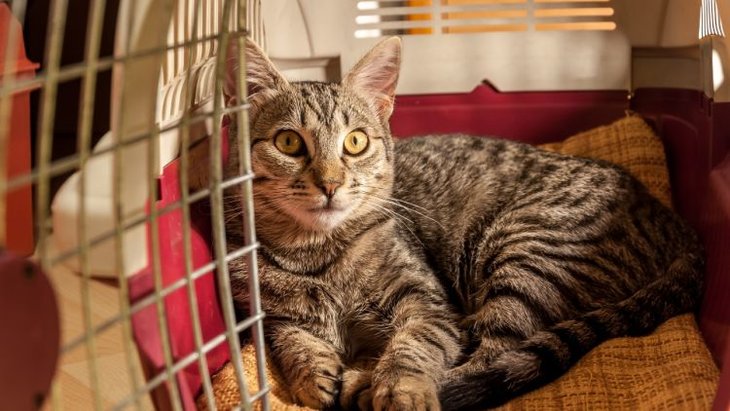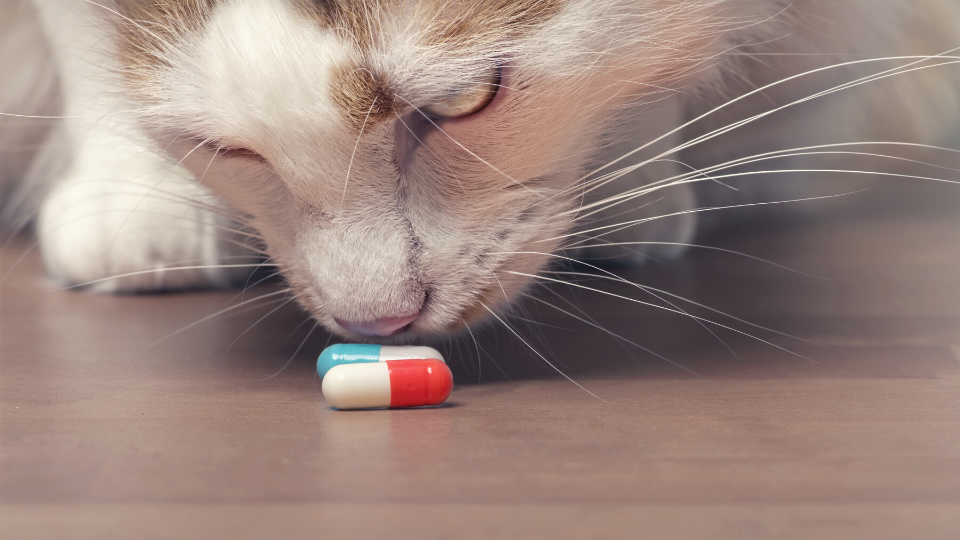Gabapentin for Cats: Uses, Dosage, Side Effects
Does your cat look forward to going to the vet? Most cats don’t, which might cause you to dread the visit just as fast. Luckily, there is an effective anti-anxiety medication for cats called gabapentin, but the uses of gabapentin in cats are not limited to anxiety. For example, it can also be used to manage several types of pain and help treat seizures.
Keep reading to find out about the other uses of gabapentin for cats, as well as the appropriate dosage, administration, and side effects of this medicine.
Table of Contents:
What is gabapentin used for in cats?
Gabapentin is an anticonvulsant and analgesic drug used to treat chronic pain in cats, dogs, and horses.
The drug has been shown to be especially efficient in treating neuropathic pain in cats, usually in conjunction with other analgesic agents like nonsteroidal anti-inflammatory drugs (NSAIDs). Gabapentin is also prescribed for pain associated with malignancy and chronic arthritic pain in cats.
Originally developed to control seizures in humans, gabapentin can also be used to treat seizures in animals, usually combined with other anti-seizure drugs. In some cases, gabapentin can be prescribed as adjunctive therapy for cats and dogs with refractory idiopathic epilepsy.
While the drug is not labeled for use for anxiety, it has been increasingly used in veterinary medicine to treat anxiety and fear associated with stress in cats, especially while on the way to a vet visit. The number of clinical studies into gabapentin’s efficacy in cats has been limited, but a study from 2017 published in the Journal of the American Veterinary Medical Association confirmed that administering the medication to cats 90 minutes prior to a vet visit significantly reduces signs of stress-related behaviors during transportation and examination.
Pro Tip: Many pet insurance providers allow you to claim treatments for behavioral problems, including anxiety, under policy coverage.
Gabapentin for Cats: Dosage
The proper dosage, frequency, and form of administration for gabapentin should be determined by a vet according to the condition being treated, your cat's body weight, as well as their individual needs.
Gabapentin is given orally in the form of a tablet, capsule, or liquid. The drug can be administered with or without food, but if your cat vomits after taking Gabapentin on an empty stomach, consider giving future doses with food (or, even better, right before feeding).
The drug doesn’t have a strong taste and is usually well accepted by cats when given in liquid form or with food/treats. Be sure to measure liquid compounds of Gabapentin carefully. Note that some liquid formulations contain xylitol, a sweetener that’s toxic to dogs although not known if it is toxic to felines.
Gabapentin takes effect quickly, typically within one to two hours, and improvement in clinical signs should soon follow. The medication has a short half-life of about two to four hours.

The use of gabapentin to treat pain and seizures in feline patients is ‘extra label’ or ‘off label’. This means that the instructions provided by your vet might differ significantly from those on the label, which is why it is important to follow your vet’s instructions very carefully.
Gabapentin should not be discontinued abruptly in cats with epilepsy, especially after long-term use. It is ideal to wean off the medication over a period of about two to three weeks in order to reduce the risk of withdrawal seizures. Always consult your vet before stopping any medication.
If you miss a dose of Gabapentin, give it as soon as you remember. However, if it’s almost time for the next dose, skip the missed dose and take the next dose when it is due. Don’t give your cat two doses at once. Gabapentin is a short-acting drug and should stop working within 24 hours, even though effects can last longer in cats with kidney or liver disease.
Gabapentin for Cats: Side Effects
The most common side effects of Gabapentin include sleepiness, occasional diarrhea, and incoordination. Some vets have experienced that higher doses of Gabapentin lead to sedation in cats with chronic kidney disease (CKD).
In order to alleviate these side effects, the drug should be started in smaller doses and then gradually increased over time. It can also cause a false positive reading on urinary protein tests.
Overdose would likely cause increased severity of side effects including drowsiness, lethargy, ataxia, and depression. If you suspect an overdose or an adverse reaction to the medication, be sure to contact your vet or an emergency facility right away. If recognized promptly, gastric-emptying protocols including activated charcoal, cathartics, and emesis can be helpful.
Some people can predict the future.
For everyone else, there's pet insurance.
Looking to save on vet bills? See which pet insurance is right for you.
Instant results. 1M+ pet parents served.
⭐⭐⭐⭐⭐ 4.9 stars across hundreds of reviews.
Precautions when Using Gabapentin
Gabapentin should not be given to cats who are allergic or hypersensitive to it. It should be used cautiously in veterinary patients with decreased liver and renal function.
This medicine should be used with extreme caution in cats with kidney problems, as the drug is eliminated from the body through the kidneys.
In laboratory animals, the drug was associated with birth defects and fetal loss. It’s also present in milk, which means that it should be used with caution in pregnant and nursing cats.
Gabapentin Drug Interactions
Gabapentin has been found to be more effective for pain management at the beginning of treatment when given in conjunction with another pain reliever such as morphine and hydrocodone. After a while, the second drug can be left out and gabapentin will remain the only pain reliever in the therapy.
Gabapentin should not be given within two hours of administering antacids or the antacids will obstruct the absorption of Gabapentin and make it less effective.
Make sure to let your vet know if your feline friend is taking any medications, supplements, or vitamins.
Key Takeaways
- Gabapentin is an anticonvulsant and analgesic drug used by vets to treat chronic pain, seizures, and anxiety in cats.
- Mild sedation in cats is the main potential side effect of the drug. Your cat might also experience incoordination and diarrhea.
- The dosage for Gabapentin varies depending on the condition being treated. Gabapentin should be used cautiously for pets with liver and kidney disease, as well as pregnant and nursing cats.
- Always consult with your vet before starting your feline friend on any additional medications or supplements.
Looking to save on vet bills? See which pet insurance is right for you.
Instant results. 1M+ pet parents served.
⭐⭐⭐⭐⭐ 4.9 stars across hundreds of reviews.
See which pet insurance is right for your best friend.
Do you want to find the best pet insurance?
Let's analyze your pet's breed, age, and location to find the right coverage and the best savings. Ready?
Analyze My PetAbout Pawlicy Advisor
The pet insurance marketplace endorsed by veterinarians, at Pawlicy Advisor we make buying the best pet insurance easier. By comparing personalized coverage and pricing differences we can save you a ton of money, up to 83% in some instances!
Instantly Compare Pet Insurance Plans
Guides
Determine If Pet Insurance Is Worth It
Comparison Charts
Find Your State
Dog Insurance
DVM
Ricky Walther, DVM, is a small animal general practitioner in the greater Sacramento, California area. Realizing the positive financial and medical impact that pet insurance can provide for pet parents and the profession, he lends support and advice to companies like Pawlicy Advisor "The Pet Insurance Marketplace") that simplify the process of connecting with veterinary financing resources.
